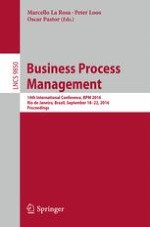This book constitutes the proceedings of the 14th International Conference on Business Process Management, BPM 2016, held in Rio de Janeiro, Brazil, in September 2016.
The focus of the conference covers a range of papers focusing on automated discovery, conformance checking, modeling foundations, understandability of process representations, runtime management and predictive monitoring. The topics selected by the authors demonstrate an increasing interest of the research community in the area of process mining, resonated by an equally fast-growing uptake by different industry sectors.
